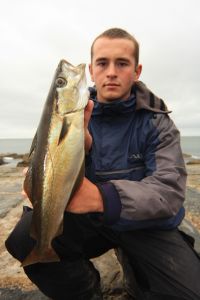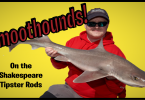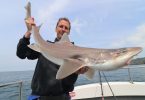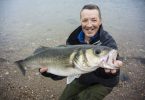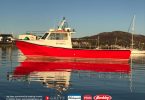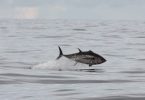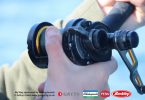In my last instalment, I ended by saying I would start looking at some of the UK’s most popular saltwater species and the best ways, and places, to target them from both boat and shore. As it’s November, what better place to start than with Pollack, as many boat anglers will be eagerly awaiting the arrival of big Pollack to the offshore wrecks.
What Is A Pollack?
The Pollack (Pollachius Pollachius) is a tough fighting sea fish that is present throughout the British Isles, from piers to rocky shorelines and offshore, on reefs and wrecks. Pollack that live close to the shore are usually less than a few pounds in weight, but offshore this species can attain sizes well into double figures. The current British records for the Pollack are Boat 29lbs 4oz and shore, a staggering 18lb 4oz!
The Pollack comes from the order of fishes called Gadiformes (Cod-Like Fishes), although the Pollack doesn’t look like a cod. Pollack and cod, like all members of the cod family, are very unusual compared to other species of fish in the fact that they all have three dorsal fins and two anal fins. The Pollack’s back is dark brown; it has a silvery belly and bronze flanks. It has an extremely sensitive lateral line and a body shape designed to allow it to swim fast. The Pollack has huge eyes enabling it to see its prey clearly at distance, and a huge mouth with an extending lower jaw, which tells us that this fish likes to attack from beneath. The Pollack is one of the UK’s fastest growing species and it’s not hard to see why – the Pollack is a hunting machine designed for eliminating huge amounts of small fish, or prawn, in order to satisfy its hungry appetite! Find an obstruction like a pier, rocky headland or offshore wreck or reef and there is certainly a Pollack around somewhere. A Pollack will rest whilst there is no tide but as tides run, they wake up and start feeding.
The key, and the skill, in Pollack fishing comes from bait presentation. Live baits have to be presented perfectly and lures have to be worked until the correct action and retrieve speed is found. Sometimes, a Pollack will take dead-baits, like mackerel slithers or squid etc, but generally this species like to kill its own dinner. The Pollack is a great fish to catch. They’re abundant, accessible to both shore and boat anglers, easy to locate, simple to target, moderately easy to hook and offer a great fight. They taste pretty good, too. Pollack are available all year round, from all UK coasts.
 Shore Fishing For Pollack
Shore Fishing For PollackLocating Pollack from the shore is pretty simple – they like deep water and they like obstructions. Pilings on piers, rocky breakwaters and rough coastlines that drop away into deep water are the perfect place to start looking. Tackle and technique is pretty simple, too.
No specialist gear is required to catch Pollack from the shore – a simple sea fishing spinning rod, pike or carp rod paired with a fixed spool reel is perfect. Rigs and end tackle are pretty simple as well. A simple sea fishing float rig, set at a depth between 6-10ft will put you in the take zone. Another simple technique is to deep spin baits and this method is great for Pollack fishing when they are feeding deeper, over kelp and rock ledges, where a simple float set-up cannot get. To deep spin baits, all you need is a simple running ledger rig, with 1-3ozs of weight and a short hook length of 3-4ft. You cast out, let the bait sink, and then retrieve to make the bait life-like just like you would if you were lure fishing.
For both float fishing and deep spinning for Pollack, 12-15lb clear monofilament or fluorocarbon, and hooks in the 1/0-3/0 size, will be perfectly adequate.
Lure fishing from the shore for Pollack is very successful, too. They will take all manner of lures including soft-baits, diving plugs and spinners.

A quick tip… If you want to target your first Pollack from the shore, dawn and dusk is often the prime time for a bite, with this species being more active at these times.
Boat Fishing For Pollack
Locating Pollack from a boat is just as simple as locating them from the shore. The small private boat angler can access all the marks that a shore angler would, like piers, breakwaters and headlands but also any underwater features like reefs and wrecks. Many reefs and wrecks are clear to see and simple to find on today’s modern GPS navigation systems and they will also be printed on traditional paper navigation charts. If you do not have access to a boat, most UK charter boats target Pollack for their customers daily.
 Offshore Pollack fishing from a boat is different than the shore as you are to need some specialist tackle. Inshore it maybe possible to fish for Pollack using a sea fishing spinning rod, or similar coarse fishing rod, but for offshore deepwater Pollack fishing over wrecks and reefs, you will need a specialist boat rod and a multiplier type reel. A good all-round rod, for Pollack and general boat fishing is a 7ft 12-20lb (test curve) boat rod. Reel mainlines and hook lengths should be 15-20lb.
Offshore Pollack fishing from a boat is different than the shore as you are to need some specialist tackle. Inshore it maybe possible to fish for Pollack using a sea fishing spinning rod, or similar coarse fishing rod, but for offshore deepwater Pollack fishing over wrecks and reefs, you will need a specialist boat rod and a multiplier type reel. A good all-round rod, for Pollack and general boat fishing is a 7ft 12-20lb (test curve) boat rod. Reel mainlines and hook lengths should be 15-20lb.
The technique for offshore Pollack fishing is very different to shore fishing and inshore boat fishing for Pollack. A rig called a flying collar rig is used to lower live-baits and lures, which are mounted on long traces (hook lengths from 8-15ft), down to the reef or wreck below without them tangling on the way down. Depending on the depth and conditions, anything from 6-12ozs of lead will be required to get the tackle to the seabed. Once the tackle reaches its destination, the angler engages the reel and retrieves to impart action into the lure or live-bait to make it swim in a life-like manner. This is repeated until a fish takes.
Top baits for Pollack fishing from both boat and shore include live and dead sandeel (and launce, also known as greater sandeel), King Ragworm, mackerel slithers (long cuts of silver mackerel fillet) and, of course, lures.
A quick warning: Bullying Pollack to the surface in deep water can often damage this fish’s swim bladder and other body parts. Playing fish gently will help returning Pollack alive that are not intended for the table.
Next time, we will take a look at the nation’s favourite eating fish, the Cod.
Jim O’Donnell
Angling guide, fishing journo & photographer
Website www.jim-odonnell.co.uk (currently under reconstruction)
Jim also runs a successful holiday operation organizing package fishing holidays to the sport fishing capital of the world, the Florida Keys. If the prospect of catching huge Tarpon, Bonefish and Permit excites you, why not join Jim in the Florida Keys? Check out his Florida Holiday website at www.fishinginflorida.co.uk













